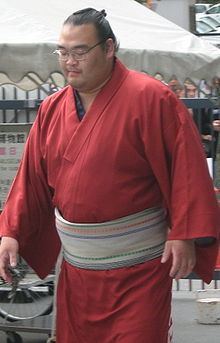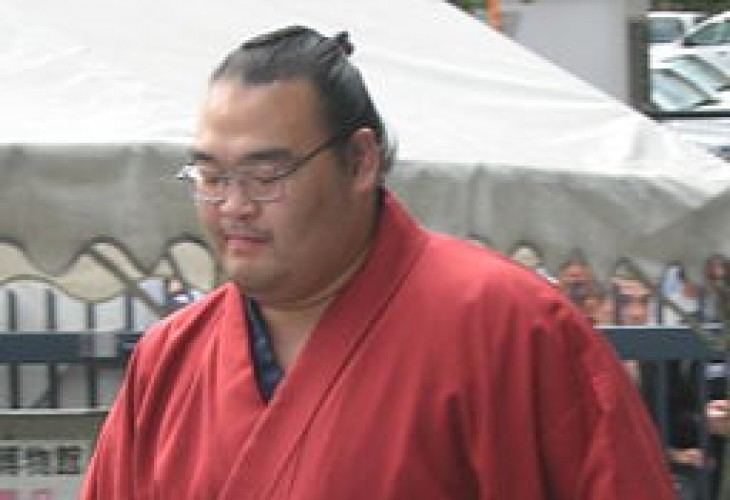Record 563-564-46 Name Takamisakari Seiken Height 1.88 m Debut March 1999 Role Sumo Wrestler Weight 138 kg | Retired January 2013 Martial art Sumo Championships 1 (Juryo) Division Juryo (since 2011) | |
 | ||
Highest rank Komusubi (September 2002) Special Prizes Outstanding Performance (1)Fighting Spirit (2)Technique (2) Similar People Kaio Hiroyuki, Asashoryu Akinori, Miyabiyama Tetsushi, Wakanosato Shinobu, Kotooshu Katsunori | ||
Popular Videos - Takamisakari Seiken
Takamisakari Seiken (born May 12, 1976 as Seiken Katō) is a former sumo wrestler from Aomori Prefecture, Japan. A former amateur champion, he turned professional in 1999 and established himself in the top division in 2002 after a brief appearance in 2000. He received five special prizes for his achievements in tournaments and earned two gold stars for defeating yokozuna. The highest rank he reached was komusubi, which he held on two occasions. He was one of the most popular wrestlers in sumo in his time, largely due to his eccentric warm-ups before his matches. He retired in January 2013 and is now a coach at Azumazeki stable, having taken the toshiyori-kabu Furiwake-oyakata.
Contents
- Popular Videos Takamisakari Seiken
- Popular Takamisakari Seiken Sumo videos
- Career
- Retirement
- Fighting style
- In popular culture
- References

Popular Takamisakari Seiken & Sumo videos
Career

Born in Itayanagi, Kitatsugaru District, Katō was an amateur sumo champion at Nihon University, winning the College Yokozuna title in his final year. He began his professional sumo career as a makushita tsukedashi (a promising amateur allowed to start at a level significantly higher than entry level) in March 1999, wrestling under his own name. He reached jūryō, the second-highest division, in January 2000, at which point he changed his fighting name to Takamisakari.
Three tournaments later, in July of the same year, he was promoted to the top makuuchi division, becoming only the second wrestler (and first Japanese born) from his Azumazeki stable to achieve this feat. In September he acted as tsuyuharai ("dew-sweeper", an honorary attendant) in stablemate Yokozuna Akebono's ring-entering ceremony, but he was injured on the third day of that tournament. Enforced absence from the next two tournaments saw him demoted all the way back to the unsalaried makushita division, where he had begun his career. It took him until March 2002 to work his way back up to the makuuchi division, and in September he reached komusubi, his highest rank to date. He only held this rank for one tournament, however, dropping back to maegashira in November. He has earned five special prizes, and has two gold stars for defeating yokozuna, both earned in the July 2003 tournament where he was also awarded the Outstanding Performance prize. Although he again reached komusubi in November 2003, he again failed to retain the rank and spent the rest of his career in the top division as a middle-level maegashira.
Takamisakari again appeared in a yokozuna's ring-entered ceremony in September 2005, when he replaced Asasekiryū, who was injured, as sword-bearer. On the first day he accidentally scraped the sword against the ceiling.
He came close to demotion from the top division after missing five bouts through injury in November 2007. However, in the next tournament he achieved a majority of wins against losses from the maegashira 14 ranking. In May 2011 he could score only 7-8 at maegashira 15 but actually rose one place in the rankings for the following tournament due to the large number of wrestlers retiring over a match-fixing scandal. However his run of 56 consecutive makuuchi tournaments ended when he could only score 3-12 in the July 2011 basho.
Takamisakari was a hugely popular wrestler. He built himself up for each bout with a somewhat eccentric series of muscle flexes and slaps, and threw a copious amount of salt onto the dohyō. In a culture where impassivity is sometimes seen as a sign of strength, he made no attempt to hide his emotions, obviously elated after each win and inconsolably dejected after each loss. Even though he usually performed in the middle to lower ranks, the winner of his matches were always greatly rewarded with kenshō-kin (prize money) provided by his sponsor, a food company.
Retirement
Takamisakari announced his retirement on day 15 of the Hatsu basho, January 27, 2013, approximately one hour after defeating Wakakōyū, as his 5–10 record at the rank of Juryo 12 would have resulted in certain demotion to the makushita division. At his side were both his current stablemaster, the former Ushiomaru, and his previous stablemaster, the former Takamiyama. He told reporters, “I have been cheered by people around the nation. I am humbled, embarrassed and delighted at the same time.” He will stay in sumo as a coach at his stable under the elder name Furiwake-oyakata.
Fighting style
Takamisakari had a straightforward fighting style, rarely resorting to sidestepping at the initial charge. He favoured yotsu techniques, preferring a right-hand inside, left-hand outside grip on his opponent's mawashi (migi-yotsu), and 26 of his 41 wins between July 2007 and May 2008 were by yori-kiri, or a simple force out. He was also known for his effort and technique at the edge of the ring, which often allowed him to win matches in which just a moment earlier it appeared that he would be pushed out.
